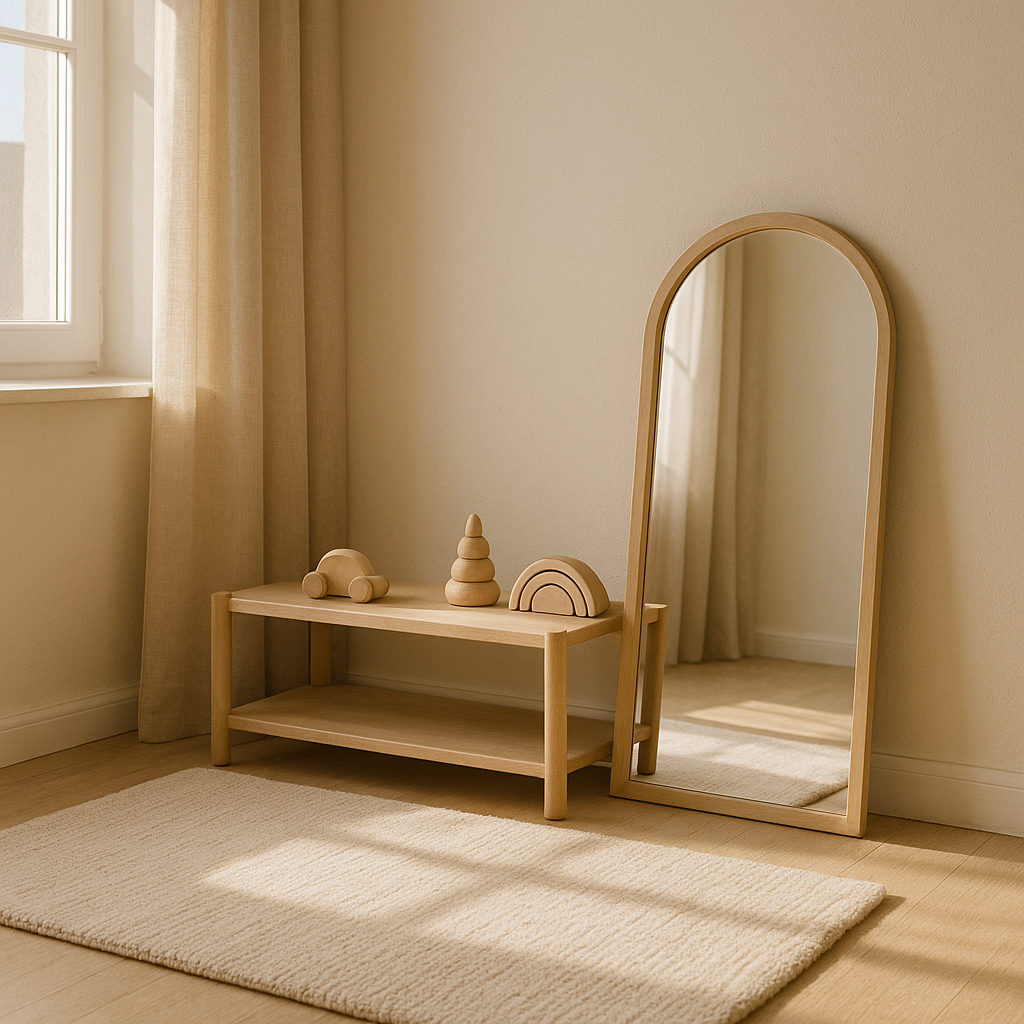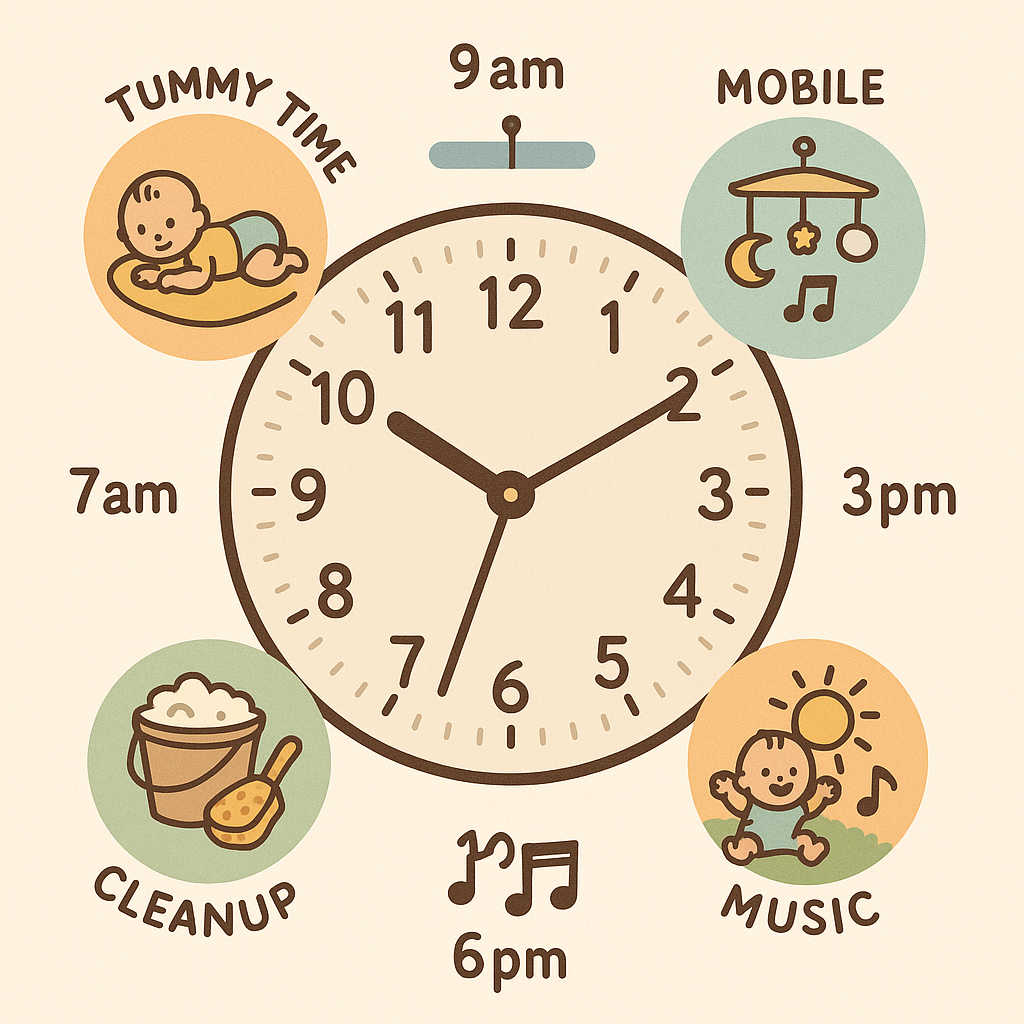Research suggests that just ten minutes of self-directed play daily can significantly enhance a baby’s attention span by age two, fostering cognitive growth without expensive equipment. Learn more about the benefits of play for child development. All you need is a safe space, a few thoughtful materials, and the confidence to let your baby explore. This guide shows how to integrate Montessori principles into daily life from birth, helping your baby develop focus and independence while you enjoy a moment of calm.
- What is Montessori independent play and why start in the first year?
- How can I create a Montessori “yes space” that’s truly baby-safe?
- Which Montessori-friendly toys and materials best spark solo play from 0–12 months?
- How do I gradually extend my baby’s independent play time?
- What is the caregiver’s ideal role—guide, not entertainer?
- How can I solve common roadblocks to independent play?
- What does a Montessori-aligned day of baby play look like?
- What does the science actually say about independent play and brain development?
- Quick-fire Montessori independent play FAQ
- How will early independent play shape your child’s future?
What is Montessori independent play and why start in the first year?
Montessori independent play is baby-led exploration that promotes autonomy from day one. Play is “the work of the child,” even newborns learn by interacting with their environment. Early stats to keep in mind: most babies manage only 30–45 seconds of solo play at first, but that window expands quickly when it’s a daily habit. By nurturing these moments, you’re strengthening attention, problem-solving, and self-confidence—skills that screens rarely offer.
Infants typically engage in brief solo play initially, with durations increasing as it becomes a habit. For more on independent play durations, see this guide. For a deeper comparison, explore why active learning trumps passive media in Play vs. TV: Why Active Learning Boosts Baby’s Brain.

How can I create a Montessori “yes space” that’s truly baby-safe?
A “yes space” is a prepared environment where every item is safe for your baby to explore freely. This eliminates the need for constant “no” interventions, fostering confidence.
Checklist for a Safe Setup:
- Use low shelves or baskets at floor level for easy access.
- Provide a firm floor mat or mattress for free movement; add a grounded mirror to encourage body awareness.
- Ensure no choking hazards smaller than 1.25 inches, per AAP safety guidelines.
- Limit visible items to 5–7 to avoid overwhelming your baby.
- Use gates or foldable playpen panels for small spaces; roll-away mats work for shared rooms.
Tip for Small Spaces: Store rotated toys in a labeled tote under furniture. For travel, a foldable play rug and nesting baskets create a portable yes space.
Internal inspiration: many of the brain-boosting setups in Boost Your Baby’s Brain Power rely on the very same principles.

Which Montessori-friendly toys and materials best spark solo play from 0–12 months?
Select open-ended, passive objects that encourage action over reaction. Here’s an age-by-age guide:
- 0–3 Months: Munari mobile, black-and-white cards, soft cloth for tactile exploration. Pair with High-Contrast Books: Boosting Newborn Brain and Vision.
- 3–6 Months: Grasping beads, crinkle paper, DIY treasure basket with safe household items (e.g., wooden spoon, silk scarf). Place 6–8 textures in a shallow basket; refresh weekly.
- 6–9 Months: Rolling bell cylinder, object-permanence box for cause-and-effect learning. See more in Cause-and-Effect Play: Sparking Your Baby’s Curiosity.
- 9–12 Months: Stacking cups, simple blocks, and an open cup for water sips; pediatric speech-language pathologists note that open cups strengthen oral muscles needed for clear speech.
For spatial magic, rotate between cups and blocks as explained in Blocks and Cups: Boosting Your Baby’s Spatial Skills.
How do I gradually extend my baby’s independent play time?
Start with connection, then step back. A 5:1 ratio of together time to solo play (e.g., five minutes of engagement for one minute alone) builds trust. Gradually extend solo play weekly.
Progression Steps:
- Stay within arm’s reach, engaging in a quiet task like folding laundry.
- Move out of sight but maintain verbal presence (e.g., humming).
- Use a routine cue (e.g., after morning diaper change) to signal solo playtime.
- Track progress with a printable sheet to celebrate small gains.
Consistency fosters trust, which enhances focus. One parent shared, “After two weeks of daily play, my 6-month-old went from fussing after a minute to exploring for 10 minutes happily.”
What is the caregiver’s ideal role—guide, not entertainer?
Your role is to prepare the environment and observe. Model tasks, narrate actions, then pause before intervening. Waiting three seconds before stepping in encourages independence, reducing interruptions significantly.
Phrase bank to encourage autonomy:
- “I see you’re working hard on that ball.”
- “Would you like the cup or the spoon?”
- “You did it all by yourself!”
Need parallel-play ideas? Craft simple household tools from DIY Baby Toys: Budget-Friendly Brain Boosters and use them alongside your child.
How can I solve common roadblocks to independent play?
Challenges often arise from emotional or sensory overload.
Here are typical challenges and quick fixes:
- Separation anxiety (8–10 months): practice “shadow play”—stay visible but silent until calm returns.
- Overstimulation from flashy toys: swap in a sensory basket of fabrics or natural objects and borrow ideas from 10 Sensory Play Ideas to Spark Your Baby’s Brain.
- Neurodiversity considerations: offer one-sense materials (e.g., weighted ball only) and shorten rotations to every week.
- Sibling interruptions: use individual “work rugs” and stagger play times.
What does a Montessori-aligned day of baby play look like?
A balanced routine threads short bursts of solo exploration between rich connection moments.
Sample day:
- 7 am – Tummy-time mirror session (see Tummy Time Benefits).
- 9 am – Three-minute mobile gazing while you prep breakfast.
- Noon – Outdoor blanket with a nature treasure basket (learn more at Nature Play).
- 3 pm – Music shaker fun, drawing from Music for Babies: Does It Boost Brain Development?.
- 6 pm – Block clean-up alongside you, closing the loop on independence.

What does the science actually say about independent play and brain development?
Self-directed play activates the prefrontal cortex, supporting planning and focus. A 2022 study found infants engaging in early exploration scored higher on executive-function tests at 24 months. Read the study here.
Mirror-neuron research shows babies observing their hands in a mirror strengthen problem-solving pathways. Conversely, AAP data links excessive screen exposure to shorter attention spans, hence, another vote for active play. Understand the impact of screen time on attention spans.
Dive deeper into the comparison in Play vs. TV: Why Active Learning Boosts Baby’s Brain.
Quick-fire Montessori independent play FAQ
-
When can I start?
From birth. Even 30 seconds under a mobile counts. -
How many toys should be out?
Five to seven. Rotate every two to three weeks to keep interest high. -
Is pretend play okay for babies?
Yes, if it mirrors real life. Feeding a doll is fine; dragons can wait. -
What if my baby cries when I step away?
Reset with connection. Brief protest is normal; persistent distress means they need you. -
Do I need expensive gear?
No. A wooden spoon often beats any battery toy.
For more developmental games, explore Peek-a-Boo Games: Teaching Your Baby Object Permanence.
How will early independent play shape your child’s future?
Starting independence play now nurtures a lifelong learner who trusts their abilities, solves problems creatively, and focuses deeply. By creating a simple yes space, rotating a few open-ended toys, and honoring your role as a gentle guide, you’re laying neural foundations for resilience—and gaining yourself calmer mornings in the process.
Ready for the next step? Download our printable toy-rotation tracker and spark fresh ideas with 10 Sensory Play Ideas. Enjoy watching your baby grow more capable each day—you’ve set the stage beautifully.